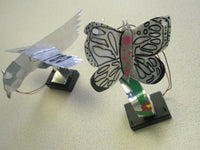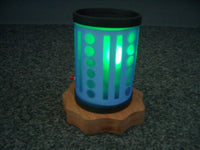

Description
Same Day Dispatch
- Orders placed online before 3:00pm Monday - Friday (excluding public holidays and our Christmas shutdown period) are always dispatched the same day provided the goods are in stock. If the goods are not in stock we will endeavour to contact you as soon as possible to discuss a dispatch date.
UK Deliveries
- If you live on the UK mainland and don't have any large materials or lithium batteries in your order it will cost £3.95 (£4.74 including VAT) if you spend less than £40 (£48 including VAT).
- If you spend between £40 and £200 (£48 - £240.00 including VAT, excluding large materials or lithium batteries) delivery is free to most locations, £12 (£14.40 including VAT, excluding large materials or lithium batteries) to Northern Ireland and £15 (£18.00 including VAT, excluding large materials or lithium batteries) to UK remote locations. For a list of postcodes that will be charged the remote location rate: remote area list.
- If you spend over £200 (£240.00 including VAT, excluding large materials or lithium batteries) delivery is free within the UK.
Rest of the world
- These orders are sent via UPS, and the cost is dependant on the service you choose at checkout. Alternatively you can choose the free collection option and have your own courier collect it from us. International orders can only be shipped to the registered card address. Please note: International orders may be charged import duty dependant on local import laws and duty rates. These charges are usually billed to you directly from UPS.
- Delivery times vary for international orders depending on the service selected and the destination. You can see the delivery time and cost at the shipping stage, or by using the shipping estimator from within the shipping basket.
Collection
- If you would like to collect your order, or use your own courier then there is an option you can select during checkout. We do not charge a packaging or handling fee for this service, and you will receive an email when your order has been processed, you can collect half an hour after receipt of this email.
Further Information
- For information about all of the delivery options we offer see full delivery details.
These Colour Changing Mood Lights were made by students at Hawkley Hall High School.
These Colour Changing Mood Lights were made by students at Hawkley Hall High School.
Mood lights using recycled pill pots and hand wash bottles and table centrepiece using colour changing LEDs & Costa straws.
Mood lights using recycled pill pots and hand wash bottles and table centrepiece using colour changing LEDs & Costa straws.
This is an adaptation of our mood light kit which uses a colour changing LED. A simple 555 timer was also added to control the length of time the LED...
This is an adaptation of our mood light kit which uses a colour changing LED. A simple 555 timer was also added to control the...
Thank you for your message, there is still a positive and negative leg on these LEDs. The LED should have a slightly flatter edge on one side and this is the negative pole. These LEDs are normally rated to 4.5V so if you are measuring 8V on the circuit you would need a resistor.
Best Regards
Cullen
Thank you for your email, unfortunately not really. If it did work it would be very dim as normally these LEDs require a 4.5V supply due to the common cathode in the LED.
Best Regards
Cullen
Most LEDS have a life span of around ten thousand hours, however there is a number of factors which can alter that. for example, voltage supply..overcurrent protection, enviromental conditions..etc
These LEDs include a cathode in them which works similarly to a resistor. Thus with this kit being run from 5V you would not need a resistor for the LED.
Best Regards
Cullen
What value resistor do i need to use to power this led off 9v battery?
Hi Cian, The problem you have is this LED is designed to run off a 5V battery, and using a resistor with this is very difficult due to the fact that the current draw changes. As such if you needed to use a 9V supply for your circuit you would be best to use a 5V regulator to drop the voltage down for the colour changing LED.
Hello Indrasena, The colour changing LED has a maximum voltage supply of 5V’s. As such you shouldn’t’ use a supply that has a higher voltage than 5V’s. We also wouldn’t recommend using a car battery to power a homemade device as a car battery can provide a large amount of current and could be dangerous.
It is possible to put 4 LED's in serial without resistor.
Al
You wouldn’t be able to place a number of the colour changing LED’s in series to allow you to use a high rated power supply. This is due to the forward voltage constantly changing while the LED cycles through the different colours, as each colour requires a different forward voltage. As such if you had a number of these in series you could either not have enough forward voltage for each LED, or when they require a smaller forward voltage you could cause the LED’s to become damaged as the supply voltage then becomes more than what is required by the LED’s.
The voltage is ok, you should check the maximum current your transformer can supply though. If it is over 300mA you should be fine
Although it is possible to run this off a high voltage using resistors it would cause issues with the LED. This is due to the fact that each colour requires a different current, by having a resistor already in the circuit would mean you are limiting the current twice, and would likely stop the sequence running correctly.
You wouldn’t be able to run these LED’s at a higher voltage of 5V’s and use resistors to bring the current down. This is due to the fact that each colour requires a different current and as such you wouldn’t be able to limit it without limiting the way the LED works.
The LED’s are fine working at 4.2V, it has a built in current limiting for any voltages up to 5V. You will be fine to put the LEDs in parallel with the batteries and you won’t have any problem. The wattage of the heater want make a difference, as the LED’s will only draw about 25mA each when wired in parallel with the batteries.
You wouldn’t be able to wire this circuit in series as you would need a supply voltage of 200v DC to give each LED 5V. The best option is to wire the circuit in parallel. Please be aware that each LED can only be run at a maximum of 5V.
Hi Barry, The LED’s shouldn’t be burning out as they don’t need a current resistor and they can handle a power supply of up to 5V. To understand why this might be happening I need some more information, such as the rating on the power supply and ideally a photo of the circuit. If you can supply this to me in an email to support@kitronik.co.uk then we can try and solve the problem.
The sequence is as followed: Red, green, blue, yellow, cyan, magenta then back to the beginning of the cycle. As the change is a gentle fade you do get colours between these in the cycle, such as the fade between red and green will produce an orange/yellow glow for a short period before fully changing to green. The time between each change varies depending on what the next colour in the sequence is, so the amount of time the colour stays on for does vary slightly although there isn’t a large difference in time variations.
I am trying to use this LED to light an ornament along with your coin cell power board package 2145, but I don't know how long it will drive the LED - these batteries have a low capacity I understand? Any suggestions on getting more than a few hours without a huge battery pack?
Your simplest option for a longer life would be 3x AA batteries. A good AA battery will have a capacity of around 1500mAh so would last for around 38 hours with a colour changing LED. Mobile phones use lithium ion batteries which would be good choice on size, but whilst these are compact circuits for charging them are very complex.
Without knowing more about the lamp it's impossible to say.
Thanks Tim
Once you have either determined that you have a 5V supply or regulated to 5V you then want to connect the LEDs in parallel, so all the flat edges connect together and to 0V and all the other leads connect together and to 5V.
Ask a question about this product
Payment & Security
Your payment information is processed securely. We do not store credit card details nor have access to your credit card information.



